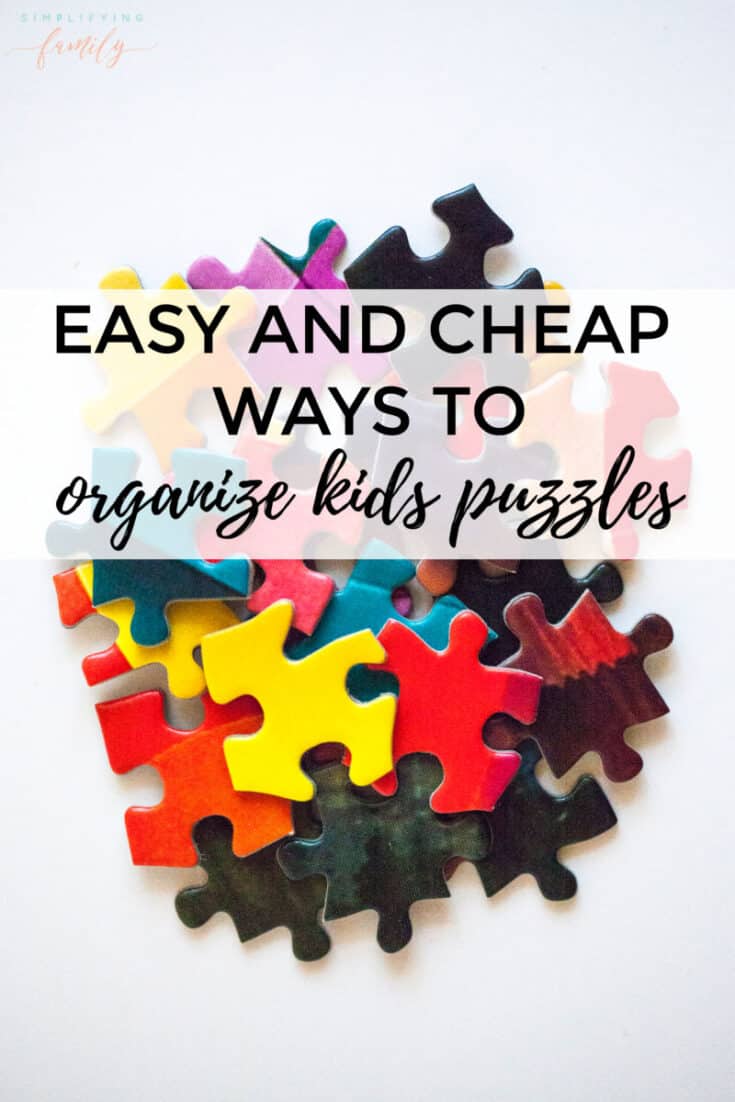5 Easy and Cheap Ways to Organize Puzzles at Home
Puzzles and board games for kids are great learning tools. But they can also lead to a big mess which results in frustrated kids, and parents. Take the frustration out of puzzle storage at home with these easy ways to organize puzzles at home!
I know how quickly the living room can become cluttered with toys, puzzles, and games. It seems like every time I turn around there’s another piece missing from the puzzle or another game board that needs to be put away.
For more tips on toy organization, you can check out this post on 10 Simple Ways to Organize Toys.

Favorite Puzzles for The Whole Family
I’ll admit that for years we only used preschool puzzles with very few pieces because either the kids would eat them, or the dog would.
As the kids have gotten older, we’ve learned that putting together puzzles is a great family activity!
The slow pace is great. It’s teaching perseverance and how one piece is part of a bigger picture. Plus the kids love it.
Together Time puzzles are great for the whole family because there are large pieces for kids, small puzzle pieces for adults, and middle-sized pieces for everyone. We LOVE them.
I have used affiliate links to help make shopping a bit easier. That only means I’ll make a small commission if you click the link and make a purchase.


5 Ways to Organize Puzzles at Home
1. Find The Pieces
If you’re lucky, all the puzzles are in their boxes with all the pieces. If you’re like us, start looking for all the pieces. Search everywhere. Places to look:
- in random toy boxes
- other puzzle boxes
- in with their clothes
- under their beds
- in with school papers
2. Puzzle Pieces, Assemble!
If only it was that easy. Consider clearing space on your dining room table or in the playroom so that each puzzle can be completed.
This puzzle storage system looks perfect for assembling puzzles.

3. Take A Picture of the Finished Puzzle
If there are missing pieces, you’ve looked everywhere, and all hope is lost, throw away the puzzle. Recycle it if you can. Use it for an art project. Do not put it in the puzzle area “just in case.” Let it go.
Take a picture of the finished puzzle to use later so you can identify what is in the box or bag.
While you can use the puzzle top, taking a picture will help with uniformity and OCD.
4. Code It For Easy Puzzle Clean-up
Flip the puzzle over and mark every piece with the same symbol. The beauty of this is when the pieces become scattered again, which you know they will, the kids will be able to tell which puzzle the piece goes with. Genius! Thanks for this tip to organize puzzles at home, Jennifer!
What symbols and shapes should you use? Start with:
- Dots
- Stars
- Squares
- Triangles
- Diamonds
- Letters from the alphabet
- Straight line
If you use different colors and mix up creating empty shapes and filled-in shapes you could come up with several different patterns to distinguish your puzzles from each other.
5. Storage Solutions For Kids Puzzles
Puzzle boxes are destroyed easily. Consider purchasing photo boxes like these. I like that since they are all the same shape our puzzle boxes will stack better and look neater. Attach a picture of the puzzle to the box and draw the symbol for the puzzle pieces on the box.

You can also store smaller puzzles in vinyl pouches like those pictured below.

Puzzles are a great way to spend some quality time together as a family, but they can be a pain to store. If you don’t have a dedicated puzzle table, the best way to organize puzzles is by investing in a puzzle roll-up mat.
These mats are made of sturdy fabric and have a foam backing that will protect your puzzle from getting bent or damaged and great ways to organize puzzles. To use one, simply lay it out on a flat surface, assemble your puzzle on top, and then roll it up when you’re finished. Most roll-up mats come with a strap that makes it easy to carry and store.
Puzzles and games can be a lot of fun for kids—but not for moms who have to constantly pick up after them! If you’re looking for a way to keep your living room tidy, then try one of these five storage solutions for ways to organize puzzles.
What tips do you have for organizing your kid’s puzzles?







